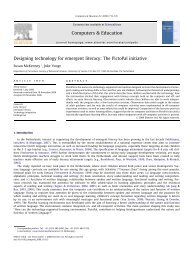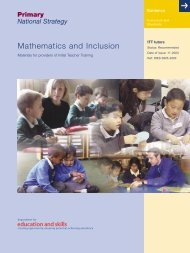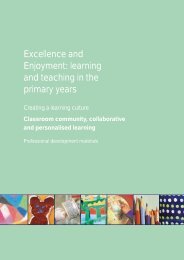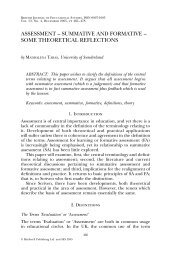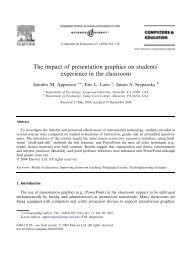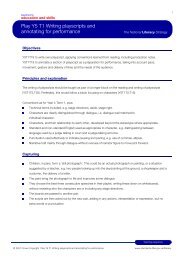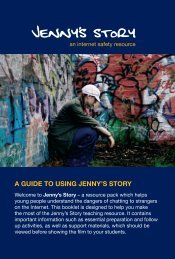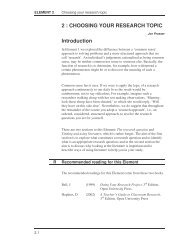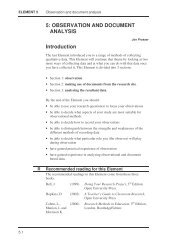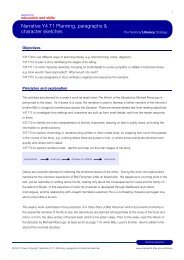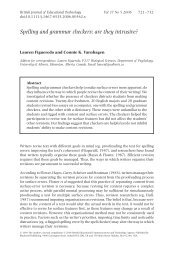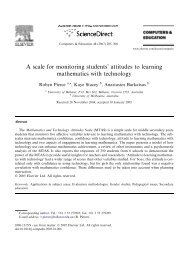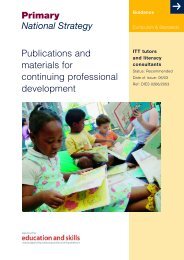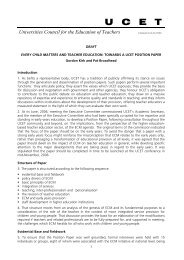Introduction to the Further Literacy Support Programme - PGCE
Introduction to the Further Literacy Support Programme - PGCE
Introduction to the Further Literacy Support Programme - PGCE
You also want an ePaper? Increase the reach of your titles
YUMPU automatically turns print PDFs into web optimized ePapers that Google loves.
FURTHER LITERACY SUPPORTHandoutsHandout 1TrainingDayINTRODUCTION TO THE FURTHER LITERACY SUPPORT PROGRAMMENational <strong>Literacy</strong> Strategy<strong>Introduction</strong> <strong>to</strong> <strong>the</strong>Fur<strong>the</strong>r <strong>Literacy</strong> <strong>Support</strong><strong>Programme</strong>The modules●The programme is divided in<strong>to</strong> three modules, each lasting four weeks.● The overall focus is on consolidating objectives from Year 4 and Year 5 terms 1 and 2.●●●Each module focuses on several text level objectives, particularly writing objectives. Theseprovide <strong>the</strong> context for developing writing in a particular form. Sentence and word levelobjectives are addressed in this context.Each module has a writing outcome.Children see writing demonstrated in <strong>the</strong> guided and supported sessions and <strong>the</strong>n go on <strong>to</strong>apply <strong>the</strong>se skills and strategies in independent writing.Module 1: Writing <strong>to</strong> Persuade● Consolidation of key objectives from Year 4●●Outcomes: Write three pieces of persuasive writing: an advert, a leaflet and a letter.Context: Children read and evaluate advertisements, write promotional material for a newproduct called ‘VIP’, and finally write a letter using persuasive language.3Module 2: Fantastic Tales● Consolidating key objectives from Year 4 and from Year 5 term 1●●Outcomes: Plan and write a s<strong>to</strong>ry.Context: Children read and evaluate examples of myths and legends. They identify keyfeatures and use <strong>the</strong>se <strong>to</strong> plan and write <strong>the</strong>ir own s<strong>to</strong>ries, editing and reviewing as <strong>the</strong>y write.Module 3: Writing <strong>to</strong> Inform● Consolidating key objectives from Year 5 terms 1 and 2●●Outcomes: Plan and write a report.Context: Children read and evaluate non-chronological reports. They identify key featuresand use <strong>the</strong>se <strong>to</strong> plan and write a report on <strong>the</strong>ir school, as well as instructions about how<strong>to</strong> get <strong>the</strong>re for a visi<strong>to</strong>r from ‘ano<strong>the</strong>r world’. They edit and revise <strong>the</strong>ir writing and plan apresentation.ivFLS Group Intervention / Training Materials 23National <strong>Literacy</strong> Strategy
FURTHER LITERACY SUPPORTHandoutsHandout 2 cont.TrainingDayOutcomeSpeaking and ListeningWrite an argument.Y4 T1 Text 16 Identifydifferent types of text, e.g.content, structure,vocabulary, layout, purpose.Y4 T1 Text 18 Select andexamine opening sentencesthat set scenes, captureinterest, etc.; pick out keysentences / phrases thatconvey information.Improve <strong>the</strong> argument.Turn it in<strong>to</strong> a letter.Y4 T1 Sentence 4 Toidentify adverbs andunderstand <strong>the</strong>ir functions insentences.Y4 T2 Sentence 1 Torevise and extend work onadjectives.Y4 T1 Sentence 3 Toidentify <strong>the</strong> use of powerfulverbs.Y4 T2 Sentence 3 Tounderstand <strong>the</strong> significance ofword order.3Week34Reading and writing targetsR Y4 Knowing how texts workIdentify key features of different types oftext and use appropriate readingstrategies.W Y4 Process Use different ways <strong>to</strong>plan writing, e.g. notes, diagrams, etc.W Y4 Spelling Attempt <strong>to</strong> spellunfamiliar words using known conventionsand rules, and a range of strategies … .R Y4 Knowing how texts workIdentify key features of different types oftext and use appropriate readingstrategies.W Y4 Process Edit in relation <strong>to</strong>audience and purpose, enhancing ordeleting, justifying choices.W Y4 Style: sentence constructionVary sentences, showing characteristics ofchosen form, adding phrases <strong>to</strong> enhancemeaning.Key objectivesY4 T2 Word 1 To read and spellwords through: identifying phonemes inspeech and writing; blending phonemesfor reading; segmenting words in<strong>to</strong>phonemes for spelling.Y4 T2 Word 3 To use independentspelling strategies, including: soundingout and spelling using phonemes.Y4 T2 Text 19 To identify how andwhy paragraphs are used <strong>to</strong> organiseand sequence information.Y4 T3 Text 18 From examples ofpersuasive writing, investigate how styleand vocabulary are used <strong>to</strong> convince <strong>the</strong>intended reader.Y4 T3 Text 21 To assemble andsequence points in order <strong>to</strong> plan <strong>the</strong>presentation of a point of view(persuade).Y4 T1, 2 and 3 Word 2 To identifymisspelt words in own writing; <strong>to</strong> keepindividual lists and learn <strong>to</strong> spell <strong>the</strong>m.Y4 T2 Word 9 To use alternativewords and expressions which are moreaccurate or interesting than <strong>the</strong> commonchoice.Y4 T2 Sentence 4 To recognise howcommas, connectives and full s<strong>to</strong>ps areused <strong>to</strong> join and separate clauses; <strong>to</strong>identify in <strong>the</strong>ir writing where each ismore effective.Y4 T2 Text 24 To improve <strong>the</strong>cohesion of written (persuasive)explanations through paragraphing and<strong>the</strong> use of link phrases andorganisational devices.Y4 T3 Text 23 To present a point ofview in writing, linking pointspersuasively and selecting style andvocabulary appropriate <strong>to</strong> <strong>the</strong> reader.FLS Group Intervention / Training Materials 29National <strong>Literacy</strong> Strategy
FURTHER LITERACY SUPPORTHandoutsHandout 3TrainingDayFridayModule 1: Writing <strong>to</strong> PersuadeSummaryTimingMondayTuesdayThursdayIndependent activityUsing adjectives and adverbs,children create slogans thatcould be used in adverts <strong>to</strong>persuade people <strong>to</strong> buyproducts.<strong>Support</strong>ed session 1:3Finish advert by addingpersuasive claim. Evaluateadverts.Week1Duringliteracy hourGuided reading (teacher)Reading of adverts, identifyingpurpose, audience and keyfeatures.Independent activityChildren analyse an advertand describe key featuresusing a grid.Outsideliteracy hour<strong>Support</strong>ed session 1:1Using three given adverts for‘VIP’, select most effectiveadvert, explaining reasons,based on key features.SupplementaryhomeworkHomework taskChildren choose a favouritebook and note in <strong>the</strong>ir readingjournals ideas for an advertthat will persuade o<strong>the</strong>rs in<strong>the</strong> class <strong>to</strong> read it.Homework taskInvestigation in<strong>to</strong> adjectives –making text more persuasiveby changing adjectives.Week2Duringliteracy hourGuided writing (teacher)Shared writing of a leaflet for‘VIP’ using a mixture ofdemonstration, scribing andsupported composition.Independent activityChildren discuss <strong>the</strong>ir productwith a partner and use aplanning PCM <strong>to</strong> make briefnotes for own product.Outsideliteracy hour<strong>Support</strong>ed session 2:1Use leaflet template <strong>to</strong> start <strong>to</strong>draft leaflet by describingproduct.SupplementaryhomeworkHomework taskImprove a text by replacing<strong>the</strong> underlined verbs withmore powerful ones from agiven list.Homework taskSpelling investigation in<strong>to</strong> verbendings.Wednesday<strong>Support</strong>ed session 1:2Start <strong>to</strong> create own advert for‘VIP’ product. Design slogan.Homework taskInvestigation in<strong>to</strong> adverbs –constructing 10 sentencesusing a list of nouns, verbsand adverbs.<strong>Support</strong>ed session 2:2Complete leaflet by describing<strong>the</strong> product’s benefits.Homework taskReading journal: children noteeffective use of persuasivetechniques in real adverts.Independent activityChildren, working in pairs, usea prompt sheet <strong>to</strong> identifyways of improving <strong>the</strong>irleaflets.<strong>Support</strong>ed session 2:3Review and evaluate leaflets.3FLS Group Intervention / Training Materials 31National <strong>Literacy</strong> Strategy
FURTHER LITERACY SUPPORTHandoutsHandout 3 cont.TrainingDayFridayThursdayIndependent activityUsing <strong>Support</strong>ed session 3:2as a model, children writeopening <strong>to</strong> own letter.Wednesday<strong>Support</strong>ed session 3:2Complete planning ofargument. TA demonstrateswriting opening statement.Homework taskInvestigation in<strong>to</strong>homophones. Clozeprocedure task <strong>to</strong> fill inmissing homophones.<strong>Support</strong>ed session 4:2Children start <strong>to</strong> review andimprove <strong>the</strong>ir own argumentsusing checklist.TA demonstrates turningargument in<strong>to</strong> letter. Childrenwrite out argument as letter.Homework taskNote key ideas <strong>to</strong> persuadesomeone that reading is notboring.<strong>Support</strong>ed session 3:3TA demonstrates writingparagraphs in support ofargument.Children start <strong>to</strong> draftparagraphs in support of<strong>the</strong>ir own argument.Independent activityChildren complete editing<strong>the</strong>ir own letters, focusing oncorrect punctuation and useof strategies <strong>to</strong> correctspellings.When finished, children swapwith a partner.<strong>Support</strong>ed session 4:3Using ‘I can’ statements,evaluate success of ownletter and set three targetsfor personal development.3Week3Week4TimingDuringliteracy hourOutsideliteracy hourSupplementaryhomeworkDuringliteracy hourOutsideliteracy hourSupplementaryhomeworkMondayGuided reading (teacher)Look at example of argument– discuss structure and keyfeatures.Homework taskChildren write a letter <strong>to</strong> anauthor, saying which of <strong>the</strong>author’s books is <strong>the</strong>irfavourite and why.Guided writing (teacher)Teacher demonstrates writinga conclusion and introduces‘Checklist for improvingarguments’.Homework taskConnectives list <strong>to</strong> learn <strong>to</strong>spell using ‘Look, say, cover,write, check’.TuesdayIndependent activityRead a different argument,using checklist <strong>to</strong> identify keyfeatures.<strong>Support</strong>ed session 3:1TA demonstrates planning forargument. Children startplanning <strong>the</strong>ir own argument.Homework taskInvestigation in<strong>to</strong> short wordswithin long words.Independent activityChildren are given a text which<strong>the</strong>y need <strong>to</strong> complete byselecting connectives from agiven list.<strong>Support</strong>ed session 4:1TA demonstrates writingconclusion <strong>to</strong> argument.Children complete argumentsand start <strong>to</strong> review.Homework taskFrom a starting sentence,write eight new sentences bychanging one word each time.FLS Group Intervention / Training Materials 33National <strong>Literacy</strong> Strategy
FURTHER LITERACY SUPPORTHandoutsHandout 4TrainingDayModule 1 Writing <strong>to</strong> Persuade (Weeks 1–4)Target planWeek 1Evaluatingadverts andidentifying keyfeatures <strong>to</strong> usewhen designingan advertWeek 2Writing apersuasiveleafletleafletWeek 3Arguing a poin<strong>to</strong>f viewWeek 4Completing andimproving <strong>the</strong>argument: rewritingas aletterletter written written <strong>to</strong> <strong>to</strong>persuadeTARGET PLAN3TargetTargetTargetTargetI am learning<strong>to</strong> choosewordscarefully sothat I canpersuadepeople withmy writing.I am learning<strong>to</strong> makenotes <strong>to</strong> planmy writingand turn<strong>the</strong>m<strong>the</strong>m in<strong>to</strong> in<strong>to</strong>sentences.I am learning<strong>to</strong> organisemy writing <strong>to</strong>presentinformationclearly.I am learning<strong>to</strong> edit andimprove mywriting,checking thatI have writtena good,persuasiveargument.When I am writing <strong>to</strong> persuade, I can:● choose how <strong>to</strong> present my ideas, e.g. an advert, a leaflet, a letter;● use note making as a way of collecting and organising my ideas before I write;● choose words carefully, adding adjectives, adverbs and powerful verbs <strong>to</strong> help get mymessage across;● compose sentences carefully, choosing whe<strong>the</strong>r <strong>to</strong> use long or short sentences <strong>to</strong>make a particular point;● use paragraphs <strong>to</strong> organise my ideas in a longer piece of writing;● check and correct my own spellings;● edit and re-draft my own writing;● reflect on my own writing, using a checklist <strong>to</strong> help me decide whe<strong>the</strong>r I have got betterviiFLS Group Intervention / Training Materials 35National <strong>Literacy</strong> Strategy
FURTHER LITERACY SUPPORTHandoutsHandout 5Summary for Module 1Week 1MODULE 1 WEEK 1MODULE 1 WEEK 1Summary – Week 1Focus for <strong>the</strong> week: Designing and producing an advertWeek 1MondayDuring literacy hourGuided reading(teacher)Reading of adverts,identifying purpose,audience and key features.Outside literacy hourHomework taskChildren choose afavourite book and note in<strong>the</strong>ir reading journals ideasfor an advert that willpersuade o<strong>the</strong>rs in <strong>the</strong>class <strong>to</strong> read it.Preparation andresourcesPCM 1 ‘Checklist of keyfeatures of adverts’PCMs 3–18‘Target plan’ posterPCM 2 Sudz advertHomework ActivitySheet 1Reading journalTrainingDay3TuesdayIndependent activityChildren analyse an advertand describe key featuresusing a grid.FLS Book pages 5 and 6PCMs 2–8, one per pair,or adverts frommagazines, etc.Wednesday<strong>Support</strong>ed session 1:1Using three given advertsfor ‘VIP’, select mosteffective advert, explainingreasons, based on keyfeatures.Homework taskInvestigation in<strong>to</strong>adjectives – making textmore persuasive bychanging adjectives.<strong>Support</strong>ed session 1:2Start <strong>to</strong> create own advertfor ‘VIP’ product. Designslogan.Homework taskInvestigation in<strong>to</strong> adverbs –constructing 10 sentencesusing a list of nouns, verbsand adverbs.VIP bottle – make this andlabel itVIP adverts; PCMs 10–12PCM 13 ‘Best advertscorecard’ FLS Bookpage 7PCM 1 ‘Checklist of keyfeatures of adverts’Homework ActivitySheet 2 ‘Add power <strong>to</strong>your adjectives’VIP bottleFLS Book page 8 ‘VIPtemplate’PCM 1 ‘Checklist of keyfeatures of adverts’Whiteboards and pensHomework ActivitySheet 3 ‘Silly sentences’ThursdayIndependent activityUsing adjectives andadverbs, children createslogans that could be usedin adverts <strong>to</strong> persuadepeople <strong>to</strong> buy products.FLS Book page 9 ‘Usingadjectives <strong>to</strong> createslogans’4Friday<strong>Support</strong>ed session 1:3Finish advert by addingpersuasive claim. Evaluateadverts.PCM 1 ‘Checklist of keyfeatures of adverts’Whiteboards and pensFLS Book page 8 ‘VIPtemplate’FLS Group Intervention / Training Materials 37National <strong>Literacy</strong> Strategy
FURTHER LITERACY SUPPORTHandoutsHandout 6<strong>Support</strong>ed session 1:1Week 1: Tuesday <strong>Support</strong>ed session 1:1Teaching sequenceOn your marksRecap keyfeatures of adverts:● Slogans● Exaggeration● Questions● Adjectives● Wordplay● Stated benefitsSession notes●●●●MODULE 1 WEEK 1This week we are starting Module 1 by looking at adverts and finding outhow <strong>the</strong> successful ones persuade people <strong>to</strong> buy and use <strong>the</strong> product –that is, <strong>the</strong> thing that <strong>the</strong> advert wants you <strong>to</strong> buy. This is so that later in<strong>the</strong> week, when you design your own advert, you’ll know what worksbest when you’re trying <strong>to</strong> persuade people.You already found out how adverts do this when you filled in <strong>the</strong>‘Analysing adverts’ grid. Find that page in your FLS Book page 6 andlet’s see what you found.Each child gives feedback.Today we’re going <strong>to</strong> look for some more examples of <strong>the</strong>se techniquesthat advertisers use <strong>to</strong> grab your attention, so we’ll keep <strong>the</strong> checklist asa reminder.MODULE 1 WEEK 1TrainingDay3Get setConsolidate keyfeatures(see above)GoShow children how<strong>to</strong> use key featuresFinishing lineDecide whichadvert is <strong>the</strong> mostpersuasiveRefer <strong>to</strong> targetResources●●●●●●●●●●●This is a bottle of VIP. (Show children attractive bottle labelled ‘VIP’). It’sa secret ingredient that’s been invented, and when you sprinkle it onyour food, it improves <strong>the</strong> taste <strong>to</strong> make it absolutely delicious. So if yousprinkle it on ice cream, it becomes <strong>the</strong> creamiest ice cream in <strong>the</strong>world, or on pizza, it becomes <strong>the</strong> tastiest pizza you can imagine.The makers of VIP have prepared three adverts, but <strong>the</strong>y’re not surewhich one will be best at persuading people <strong>to</strong> buy it. As a group, we’regoing <strong>to</strong> decide which one’s <strong>the</strong> most effective advert; that is, which onewill persuade people <strong>to</strong> buy VIP and use it. We’re going <strong>to</strong> use ourchecklist so we don’t forget anything.I’m going <strong>to</strong> cover up <strong>the</strong> checklist for a moment – turn <strong>to</strong> your partnerand see who can remember <strong>the</strong> six key features on it.Pairs give feedback.Now, <strong>to</strong> help us decide which of <strong>the</strong> three VIP adverts will persuadepeople best, we’re going <strong>to</strong> see how many of <strong>the</strong> key features on our listeach advert has used. We’ll fill in this scorecard <strong>to</strong> find out. I’m going <strong>to</strong>ask each pair of you <strong>to</strong> look for a particular key feature from <strong>the</strong> list, sothat <strong>to</strong>ge<strong>the</strong>r you can look at each advert in turn and decide if it’s beenused or not. Give it a tick on <strong>the</strong> scorecard if it has.Allocate each pair a key feature from PCM 1; <strong>the</strong> first pairs <strong>to</strong> finish aregiven ano<strong>the</strong>r feature.Pairs give feedback and explain <strong>the</strong>ir reasons. Add up <strong>the</strong> ticks.So, which advert used most of <strong>the</strong> key features? That means we think itwill be good at persuading people <strong>to</strong> buy VIP, because it does all <strong>the</strong>sethings on <strong>the</strong> checklist.To recap: <strong>to</strong>day we looked at how advertisers use <strong>the</strong>se key featureswhen <strong>the</strong>y design adverts. They need <strong>to</strong> choose <strong>the</strong>ir words verycarefully when <strong>the</strong>y are trying <strong>to</strong> persuade people.Refer <strong>to</strong> ‘Target plan’ poster.Remember, your learning target this week is ‘I am learning <strong>to</strong> choosewords carefully so that I can persuade people with my writing.’Tomorrow we’ll start <strong>to</strong> practise doing that.● VIP bottle – make this and label it.● PCM 1 ‘Checklist of key features of adverts’● Copies of VIP adverts PCMs 10–12● FLS Book page 7, PCM 13 ‘Best advert scorecard’● FLS Book page 6 Analysing adverts● ‘Target plan’ posterFLS Group Intervention / Training Materials 39National <strong>Literacy</strong> Strategy
FURTHER LITERACY SUPPORTHandoutsHandout 7<strong>Support</strong>ed session 1:2TrainingDayMODULE 1 WEEK 1MODULE 1 WEEK 1Week 1: Wednesday <strong>Support</strong>ed session 1:2Session notes● Today we’re going <strong>to</strong> carry on our work on how adverts persuadepeople, by starting <strong>to</strong> design our own adverts <strong>to</strong> persuade people <strong>to</strong>buy VIP.● Who can remember <strong>the</strong> six key features of effective adverts?● Children give feedback.● Good, let’s have <strong>the</strong> checklist on display as a reminder. (Display PCM 1.)●●●●●●●●●●●●●●This is our product – VIP. Can you remember it from yesterday?Children give feedback.It’s got a secret ingredient that improves or enhances <strong>the</strong> taste of <strong>the</strong>food you sprinkle it on. It could be a liquid or grains, ra<strong>the</strong>r like salt orsugar, that’ll be for you <strong>to</strong> decide. Tell me what food you would like <strong>to</strong>use VIP on, if we could buy it.Quickly take feedback.What’s important now, before we start designing our advert, is thinkingabout who we want <strong>to</strong> buy this product, because <strong>the</strong>n we can design<strong>the</strong> advert <strong>to</strong> appeal <strong>to</strong> <strong>the</strong>m. I think children of all ages might like <strong>to</strong> useVIP.Now decide, if children are <strong>the</strong> ones who would like <strong>to</strong> use VIP, whomust we persuade <strong>to</strong> buy it? Turn <strong>to</strong> your partner and share ideas.Children spend a few moments thinking, <strong>the</strong>n comparing ideas.It’s <strong>the</strong> parents who do <strong>the</strong> shopping, isn’t it. So our advert must appeal<strong>to</strong> parents as well as <strong>to</strong> children.The first thing we’ll design for our advert is <strong>the</strong> slogan, which needs <strong>to</strong>grab attention.Let’s look at alliteration first. That’s when a writer uses words that startwith <strong>the</strong> same sound, such as ‘The great green gremlin’ or ‘Simplyscrumptious’.We’re going <strong>to</strong> think of some phrases that use alliteration, and thatinclude a powerful adjective. So it could be ‘Simply scrumptious’ or‘Mouth-watering miracle’.Scribe phrases.With your partner, pick an effective adjective and use your whiteboards<strong>to</strong> try a phrase that uses alliteration (like mine did) and that you think willhelp persuade people <strong>to</strong> buy VIP.Children give feedback on <strong>the</strong>ir phrases for scribing.● Now you’ve got a phrase that uses alliteration, you’re going <strong>to</strong> finishyour slogan by adding in one of <strong>the</strong> o<strong>the</strong>r strategies. You could makeyour slogan a question, such as ‘Can you resist simply scrumptiousVIP?’ or you could use exaggeration, such as ‘VIP – <strong>the</strong> mouth-wateringmiracle’. (To describe VIP as a miracle is an exaggeration.)● <strong>Support</strong> pairs in completing slogans and writing in FLS Book page 8.● Today we’ve learned how <strong>to</strong> create a slogan that really grabs people’sattention by choosing words carefully.● Tomorrow in your independent work, you will be looking at someproducts and choosing adjectives <strong>to</strong> persuade people <strong>to</strong> use <strong>the</strong>m.3●●●●●VIP bottleFLS Book page 8 ‘VIP advert template’PCM 1 ‘Checklist of key features of adverts’Whiteboards and pensFlipchart8FLS Group Intervention / Training Materials 41National <strong>Literacy</strong> Strategy
FURTHER LITERACY SUPPORTHandoutsTrainingDay3Handout 7 cont.<strong>Support</strong>ed session 1:3Session notes●●●●●●●●MODULE 1 WEEK 1Week 1: Friday <strong>Support</strong>ed session 1:3In our last session <strong>to</strong>ge<strong>the</strong>r, you made up slogans for VIP. Read yourslogans aloud, please, and let’s check that <strong>the</strong>y really are attentiongrabbers.Children read slogans in turn.Today we’re going <strong>to</strong> finish our adverts, because at <strong>the</strong> moment we’veonly got a slogan. Then we’ll evaluate <strong>the</strong>m <strong>to</strong> see how effective wethink <strong>the</strong>y are.Let’s just remind ourselves of <strong>the</strong> key features of effective adverts bylooking at our checklist. (Refer <strong>to</strong> PCM 1.)When you look at an advert, underneath <strong>the</strong> slogan <strong>the</strong> advertiser usuallymakes a claim about what <strong>the</strong> product can do – its benefits. Remember<strong>the</strong> adverts you’ve looked at and think about <strong>the</strong> claims <strong>the</strong>y made about<strong>the</strong>ir product. Can someone give me an example of a claim?Take feedback or remind children of an example.Now what sort of techniques did <strong>the</strong> advertisers use <strong>to</strong> make thoseclaims more persuasive?Take feedback and scribe. Suggest key techniques (see left-handcolumn) if children are unsure.● I’ll show you how we could make a claim for our product, VIP.Remember we decided <strong>the</strong> intended audience is parents as well aschildren.● Scribe claim: ‘No more fussy eaters, Mum! VIP guarantees <strong>the</strong> kids willeat up – or your money back!’● Who can identify <strong>the</strong> techniques I’ve used here? (Appeal <strong>to</strong> intendedaudience, exaggeration.)● Now I’d like you <strong>to</strong> have a go on your whiteboard at making up yourown claim about your bottle of VIP.● <strong>Support</strong> individuals as <strong>the</strong>y write.● Now write it in your VIP template (FLS Book page 8).MODULE 1 WEEK 1●●●●●Share your claim with a partner and see if you can each identify <strong>the</strong>techniques that your partner has used.Children share claims and identify techniques used.This week, you’ve been learning about <strong>the</strong> key features of effectiveadverts, and using that knowledge <strong>to</strong> create your own adverts. Look at<strong>the</strong> checklist and <strong>the</strong>n look at your own advert. Did you include all thosefeatures? Could you improve your advert? Spend a few momentsthinking about that.Now let’s look at <strong>the</strong> ‘Target plan’ poster and this week’s target. Decidewhe<strong>the</strong>r you think you have learned <strong>to</strong> choose words carefully so thatyou can persuade people with your writing. Can you think of anythingyou’ve learned that you could use when you’re doing o<strong>the</strong>r types ofwriting?Children refer <strong>to</strong> target bank and reflect on personal progress.●●●●●PCM 1 ‘Checklist of key features of adverts’FLS Book page 3 ‘Target plan’FLS Book page 8 ‘VIP advert template’Whiteboards and pens‘Target plan’ posterFLS Group Intervention / Training Materials 42National <strong>Literacy</strong> Strategy
FURTHER LITERACY SUPPORTHandoutsHandout 8Key teaching and learningstrategies• Analysing• Listing• Annotating• Paired discussion• Group discussion• Highlighting• Sorting• Describing• Summarising key points• Teacher scribing• Evaluating• Giving instructions• Checking progress <strong>to</strong>wards targets• Paired writing• Teacher demonstration• <strong>Support</strong>ed composition• Predicting• Hypo<strong>the</strong>sising• Explaining strategies / ideas• Planning• Time out• Review and recap• Making linksTrainingDay3FLS Group Intervention / Training Materials 43National <strong>Literacy</strong> Strategy
FURTHER LITERACY SUPPORTHandoutsHandout 9Observation sheetSection Strategies CommentOn your marksTrainingDay3Get setGoFinishing lineFLS Group Intervention / Training Materials 45National <strong>Literacy</strong> Strategy
FURTHER LITERACY SUPPORTHandoutsHandout 10Planning and review sheetTrainingDayPlanning / review sheet for teacher and teaching assistantTeacher’s comments on guided readingMODULE 1 WEEK 1MODULE 1 WEEK 13Teaching assistant’s comments on group this weeke.g. evidence of learning; completion of independent tasks; issues arising;questions for teacherTeacher’s comments (<strong>to</strong> be added at end of <strong>the</strong> week)e.g. evidence of children transferring learning; issues arising; questions forteaching assistant3FLS Group Intervention / Training Materials 47National <strong>Literacy</strong> Strategy
FURTHER LITERACY SUPPORTHandoutsHandout 11TrainingDayWeek 6: MondayMODULE 2 WEEK 6Guided reading sessionNotes for <strong>the</strong> teacher <strong>to</strong> use in <strong>the</strong> session and for <strong>the</strong> teachingassistant’s referenceAims: To look at how <strong>the</strong> plot develops in s<strong>to</strong>riesObjectives: Y5 T1 Text 14 To map out texts, showing development and structure, e.g. its highand low points, <strong>the</strong> links between sections, paragraphs and chaptersY5 T1 Text 2 To compare <strong>the</strong> structure of different s<strong>to</strong>ries, <strong>to</strong> discover how <strong>the</strong>y differin pace, build-up, sequence, complication and resolutionExample text: The example used in <strong>the</strong>se notes is ‘Perseus and <strong>the</strong> Gorgon’s head’ PCM 2 (Week 5).●●Show <strong>the</strong> group <strong>the</strong> poster for this module and introduce this week’s target: ‘I amlearning <strong>to</strong> use paragraphs <strong>to</strong> organise a s<strong>to</strong>ry plot and move <strong>the</strong> action on.’Remind children that last week <strong>the</strong>y found out <strong>the</strong> ingredients of a fantastic talelike a myth or legend. This week <strong>the</strong>y will be planning <strong>the</strong>ir own myth or legend,using that knowledge.MODULE 2 WEEK 63Book ● Remind <strong>the</strong> children of <strong>the</strong> s<strong>to</strong>ry, ‘Perseus and <strong>the</strong> Gorgon’s head’, which <strong>the</strong>yintroduction read last week. Can <strong>the</strong> children remember <strong>the</strong> most exciting part of <strong>the</strong> s<strong>to</strong>ry?● Ask <strong>the</strong>m <strong>to</strong> imagine a staircase leading up <strong>to</strong> <strong>the</strong> most exciting part of <strong>the</strong> s<strong>to</strong>ry,with each paragraph making up a ‘step’ in that staircase.● Explain that <strong>the</strong>y will be re-reading <strong>the</strong> s<strong>to</strong>ry of Perseus and looking for evidence<strong>to</strong> answer <strong>the</strong> questions on <strong>the</strong> staircase outline: What is <strong>the</strong> challenge faced by<strong>the</strong> hero? How does <strong>the</strong> hero find <strong>the</strong> beast – is <strong>the</strong>re a journey? What happenswhen <strong>the</strong> hero confronts <strong>the</strong> beast? – Is <strong>the</strong>re an argument, a fight or a newplan? Does <strong>the</strong> hero have any help in defeating <strong>the</strong> beast? What is <strong>the</strong> outcomeof <strong>the</strong> confrontation? What are <strong>the</strong> consequences – for <strong>the</strong> beast, for <strong>the</strong> hero?Strategy ● Ask children <strong>to</strong> review <strong>the</strong>ir strategies for understanding how characters in achecks<strong>to</strong>ry are feeling.Independent ● Turn <strong>to</strong> ‘Perseus and <strong>the</strong> Gorgon’s head’ FLS Book page 29. Moni<strong>to</strong>r andreadingsupport individuals as <strong>the</strong>y are reading <strong>the</strong> s<strong>to</strong>ry and <strong>the</strong> questions.Return <strong>to</strong> ● Ask <strong>the</strong> children <strong>to</strong> share <strong>the</strong>ir analysis of <strong>the</strong> structure of <strong>the</strong> s<strong>to</strong>ry, encouragingtext<strong>the</strong>m <strong>to</strong> identify where <strong>the</strong>y would plot each paragraph on<strong>to</strong> <strong>the</strong> S<strong>to</strong>ry Staircase.● Use <strong>the</strong> enlarged copy of PCM 5 <strong>to</strong> support <strong>the</strong> discussion. If required use PCM6 as a guide or <strong>to</strong> sum up discussion. Children can follow on FLS Book page 40.● Can <strong>the</strong> children think of any o<strong>the</strong>r s<strong>to</strong>ries <strong>the</strong>y have read which would fit thisstructure?Response ● Talk about <strong>the</strong> fact that children can use this type of plan for <strong>the</strong>ir own s<strong>to</strong>ries,<strong>to</strong> textdescribing events leading <strong>to</strong> <strong>the</strong> most exciting point and <strong>the</strong>n leading <strong>to</strong>wards <strong>the</strong>conclusion, where everything is resolved. They will be using <strong>the</strong> S<strong>to</strong>ry Staircaseidea <strong>to</strong> plan out <strong>the</strong>ir s<strong>to</strong>ry later in <strong>the</strong> week.15FLS Group Intervention / Training Materials 49National <strong>Literacy</strong> Strategy
FURTHER LITERACY SUPPORTHandoutsHandout 12TrainingDayMODULE 2 WEEK 5A Greek MythPerseus and <strong>the</strong> Gorgon’s HeadPCM 2a3Long ago, Polydectes wasking of Seriphos, in a landcalled Greece. A mo<strong>the</strong>r andson, called Danae andPerseus, lived in <strong>the</strong> palace.The king wanted <strong>to</strong> marryDanae but she kept refusinghim. Eventually he sent hisguards <strong>to</strong> get her.Perseus was strong and feared nothing. He fought <strong>the</strong> guardsand defended his mo<strong>the</strong>r. The king wanted <strong>to</strong> get rid of Perseus,so he sent him on a dangerous mission. Perseus had <strong>to</strong> go andfetch <strong>the</strong> head of <strong>the</strong> Gorgon, Medusa.Medusa was one of three monstrous sisters. They could turnmen <strong>to</strong> s<strong>to</strong>ne just by looking at <strong>the</strong>m.FLS Group Intervention / Training Materials 51National <strong>Literacy</strong> Strategy
FURTHER LITERACY SUPPORTHandoutsTrainingDayHandout 12 cont.3MODULE 2 WEEK 5PCM 2bPerseus had a long and difficult journey <strong>to</strong> find <strong>the</strong> Gorgons. Thegods gave him two things <strong>to</strong> help him: a shiny shield and a sickle<strong>to</strong> cut off Medusa’s head. He tricked <strong>the</strong> Three Grey Sisters in<strong>to</strong>telling him where <strong>to</strong> find Medusa. They sent him <strong>to</strong> <strong>the</strong> OceanNymphs. The Nymphs hated Medusa and agreed <strong>to</strong> help. Theygave him winged sandals so that he could fly <strong>to</strong> <strong>the</strong> right place,and a helmet <strong>to</strong> make him invisible.Perseus reached <strong>the</strong> land where <strong>the</strong> Gorgons lived. He heard<strong>the</strong>ir terrible snoring, and <strong>the</strong> snakes on <strong>the</strong>ir heads hissingloudly. He looked in <strong>the</strong> shield <strong>to</strong> see <strong>the</strong>ir reflection. Then he cu<strong>to</strong>ff Medusa’s head. The o<strong>the</strong>r Gorgons woke up, but Perseus pu<strong>to</strong>n <strong>the</strong> helmet and flew away.It was a long and difficult journey. Eventually Perseus got back <strong>to</strong>Seriphos. He went <strong>to</strong> King Polydectes and showed him <strong>the</strong>Gorgon’s head. The King was turned <strong>to</strong> s<strong>to</strong>ne. Perseus and hismo<strong>the</strong>r were safe at last.FLS Group Intervention / Training Materials 52National <strong>Literacy</strong> Strategy
FURTHER LITERACY SUPPORTHandoutsHandout 13TrainingDayMODULE 2 WEEK 6MODULE 2 WEEK 6Summary – Week 6Focus for <strong>the</strong> week: Planning s<strong>to</strong>ry plots – fantastic talesWeek 6MondayDuring literacy hourGuided reading(teacher) IntroduceS<strong>to</strong>ry Staircase, demomappinga s<strong>to</strong>ry (e.g.Perseus) on<strong>to</strong> it.Outside literacy hourHomework taskReading journal: identifyand summarise <strong>the</strong> climaxof a s<strong>to</strong>ry read recently.Preparation andresourcesPCM 2 from Week 5‘Perseus and <strong>the</strong>Gorgon’s Head’PCM 5 ‘S<strong>to</strong>ry StaircaseOutline’ enlarged.PCM 6 ‘Perseus mappedon <strong>to</strong> S<strong>to</strong>ry Staircase’,enlargedFLS Book pages 29, 30,39 and 403TuesdayIndependent activityMap out <strong>the</strong> plot ofano<strong>the</strong>r myth on<strong>to</strong> <strong>the</strong>S<strong>to</strong>ry Staircase, as in <strong>the</strong>guided session.<strong>Support</strong>ed session 6:1Demonstrate planning amyth, using S<strong>to</strong>ryStaircase up <strong>to</strong> <strong>the</strong> mostexciting part. Childrenbegin own plan.Reuse PCM 5 –enlargement for TA. ReadPCM 8. Use PCM 7‘Planning notes for“Thespina and <strong>the</strong>Scorpidon”’.FLS Book page 39Independent taskHomework taskComparing and changingdialogue.Homework Activity 3Wednesday<strong>Support</strong>ed session 6:2Demonstrate planningthree possible resolutions:kill beast and escape;trick beast and escape;befriend beast. Childrendiscuss choices.As for <strong>Support</strong>edsession 6:1Reuse TA’s scribed noteson S<strong>to</strong>ry Staircase from 6:1Children’s S<strong>to</strong>ry StaircaseplansHomework taskChildren composesentences containingcomparative descriptions.Homework Activity 6:‘What? Even bigger thanthat!’ThursdayIndependent activityChildren plan s<strong>to</strong>ryresolution using S<strong>to</strong>ryStaircase, based on <strong>the</strong>three choices discussed in<strong>Support</strong>ed session 6:2.Children’s S<strong>to</strong>ry Staircaseplans from <strong>Support</strong>edsessions 6:1 and 6:2.Friday<strong>Support</strong>ed session 6:3Demonstrate reviewingearly part of plan <strong>to</strong>ensure that it links <strong>to</strong>chosen resolution.Reminder about usingpast tense for narratives.Review week’s learning.TA’s S<strong>to</strong>ry Staircase from<strong>Support</strong>ed sessions 6:1and 6:2FLS Book page 39Children’s S<strong>to</strong>ry Staircaseplans14FLS Group Intervention / Training Materials 53National <strong>Literacy</strong> Strategy
FURTHER LITERACY SUPPORTHandoutsHandout 14Weekly timetableMonday B LTuesday R UTrainingDay3Wednesday E NThursday A CFriday K HFLS Group Intervention / Training Materials 55National <strong>Literacy</strong> Strategy



